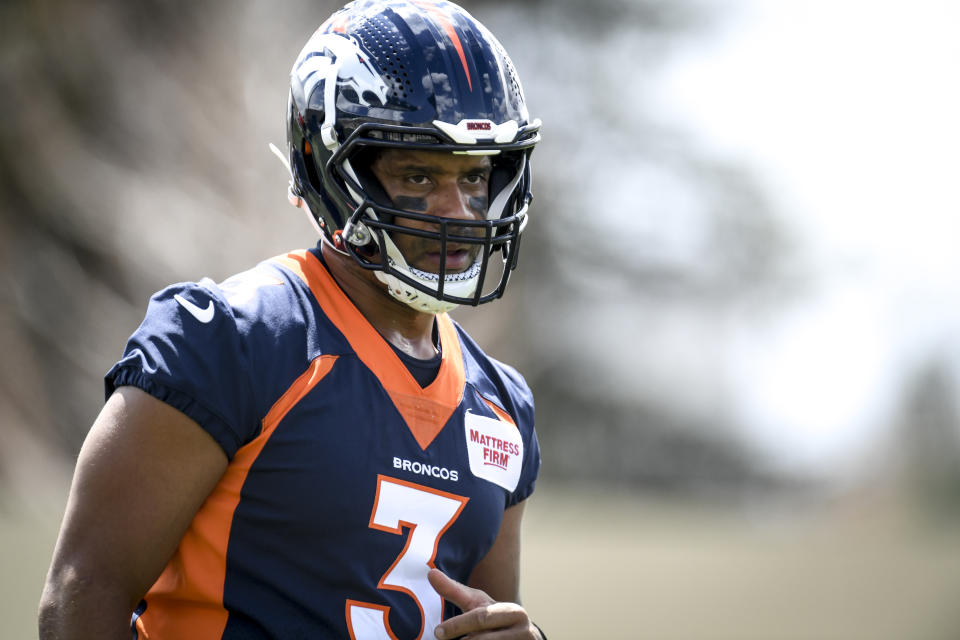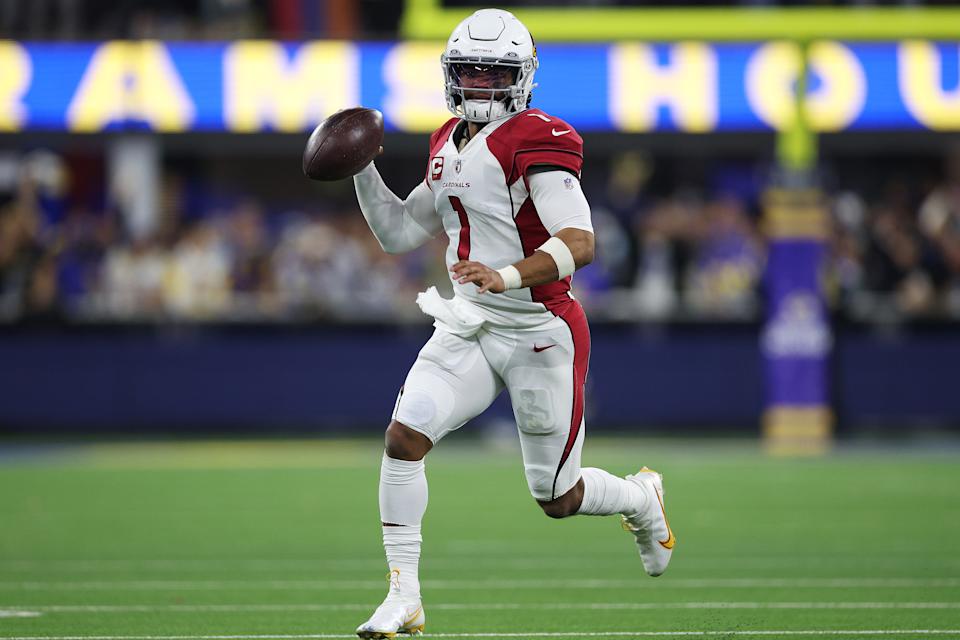Russell Wilson. Matthew Stafford. Matt Ryan. Carson Wentz, for some reason. Deshaun Watson, for very different reasons. The past year and a half has underlined the lengths NFL teams will go to for a quarterback who might unlock their Super Bowl hopes.
There are 10 teams currently projected to start a quarterback they traded for after he was already established in the league. The teams who traded away those 10 starters have netted out with eight first-round draft picks, four second-rounders and five third-rounders, in addition to later selections.
So that’s 17 picks from the first three rounds spent since October 2017 — the Jimmy Garoppolo trade is the furthest back — for quarterbacks who are something closer to known commodities. In the panicked, all-consuming search for quarterbacks, multiple picks from Day 1 or 2 stands as the going rate.
Yet over the past five drafts, only seven teams have used even two picks from the first three rounds on quarterbacks. No one has drafted three. And only 23 teams have picked a quarterback in the top three rounds at all. If we zoom out to the past 10 drafts, only six teams have taken a shot on three or more quarterbacks in the first three rounds, and almost half the league has taken one or none.
In short, NFL teams seem more willing to marshal immense resources to urgently address a “quarterback problem” than to spend some gradually to prevent such a problem from arising.
There are plenty of cases where the immediate fix works out — see the reigning Super Bowl champions — but that doesn’t make the approach ideal.
The 2022 draft, then, makes for an interesting barometer of how teams approach the position. Evaluators have unequivocally pronounced this a weak QB class.
“This is the worst group I think I’ve ever done,” an experienced scout told Bob McGinn, writing for the Go Long newsletter. “The only one that has a chance legitimately is [Kenny] Pickett. He’s the only starter. Everybody’s grasping for these guys.”
That’s indicative of the perceived range of outcomes for this year’s group, but history proves it’s as an overstatement. Certainly more than one quarterback in the draft has a chance at becoming a starter. It might not be a large chance, but when whole seasons depend on a quarterback and a quarterback costs multiple early picks … the margin between no chance and some chance starts to matter a lot in a hurry.
Recent history, however, suggests most teams, no matter the strength of the class, should stop worrying about whether to draft a quarterback — and start worrying about which one.


Not all star QBs are 1st-rounders … but most are
NFL teams are slowly, painfully evolving to better account for the uncertainty inherent in player evaluation, but plenty of hangups persist. One scout lamented to McGinn that “second-round quarterbacks almost don’t even exist.”
“It’s like you either take them in the first round or they’re not a guy,” the scout said, “outside the obvious ones like Brady and [Russell] Wilson.”
The numbers paint a more nuanced picture. Drafting a highly sought-after quarterback early is definitely better. But their hit rate remains iffy and they shouldn’t be treated as surefire saviors. And second-round quarterbacks very much exist — they just come with lower odds and lower expectations.
Using Pro Football Reference’s data to look at the past 10 drafts, the average first-round quarterback has been a team’s predominant starter in 62.7% of the seasons since. The median first-rounder has been a predominant starter in 75% of the seasons since. There have been only nine second-round QBs selected in this timeframe, but they have been a team’s predominant starter 29% of the time. Third-rounders are at a Wilson-inflated 24.3% average with a median of 11.1%.
So the scout is right that first-round grades should rule the roost, but taking two or three shots in the middle rounds over a few seasons could really pay off. Garoppolo, Derek Carr, Andy Dalton, Colin Kaepernick, Jacoby Brissett and Jalen Hurts all turned into useful players for the teams that drafted them after being taken in the second or third rounds.
This year’s uncertainty might make Day 2 a particularly good time for opportunistic teams. One personnel official summed up the 2022 draft class to McGinn like this: “I’d hate to actually be depending on picking your quarterback.”
While he was specifically talking about this year, the recent barrage of dramatic, desperate offseason moves shows teams would do well to operate as if it’s true every year.
What a ‘quarterback problem’ looks like in the NFL
In thinking about how teams would optimally acquire quarterbacks, it helps to define what good and bad signal-caller situations look like. Everyone agrees that these scenarios — assuming they even remotely align with the rest of the team’s competitive window — are solid positives:
-
Elite QB signed for multiple seasons
-
Burgeoning or competent QB signed at low cost for multiple seasons
-
Bridge QB with a burgeoning QB developing behind him
Beyond that, few situations call for standing pat. Plenty of QB rooms that don’t look worrisome for the upcoming season still carry imminent risks.
Take the Los Angeles Rams or Dallas Cowboys. They drafted Jared Goff and Dak Prescott, respectively, in 2016. They both became solid starters despite varying pedigrees, and eventually they both approached inflection points where doubts swirled about whether they were long-term solutions for their teams.
The Rams never drafted another quarterback, instead extending Goff right before the 2019 season on the heels of a Super Bowl trip and his best year as a pro. Two years of limited production later, the Rams then spent a boatload of draft capital, including two first-round picks, to turn Goff into a very good (but not elite) quarterback in Stafford.
Would they have found a similarly useful talent if they reappropriated a high draft pick or two to the quarterback position? It’s impossible to say, but it’s also very possible that path may have kept them in contention — only with their first-round picks still in the fold.
Prescott, meanwhile, proved himself more than capable of leading a competitive team, but the gruesome ankle injury that ended his 2020 season left Dallas — which had drafted only a fifth-rounder and a seventh-rounder in the intervening years — in the vulnerable position of extending a quarterback rehabbing a serious injury or starting over.
They ended up signing Prescott to an extension last spring, and while it seems like the right decision, the Cowboys remain an injury way from having no answer at QB.
On another part of this spectrum, we have the Chicago Bears. They bet the house on Mitchell Trubisky — a failure of evaluation, but we won’t knock the idea. Where they erred is never hedging that bet. With Trubisky’s performance signaling over and over that he wasn’t extension material, the Bears didn’t select another quarterback until Trubisky was out the door. They landed Justin Fields, but could have easily delayed their way up a creek and into a draft like 2022, where no prospect carries a similar level of expectations.
No one wants to miss on a top-of-the-draft QB pick, but it behooves them to own the mistake and attempt to fix it when they do. The New York Jets turned Sam Darnold into second-, fourth- and sixth-rounders and started again with Zach Wilson.
The Arizona Cardinals, meanwhile, pulled the rip cord even faster by selecting Kyler Murray and dealing Josh Rosen for a second-rounder and a fifth-rounder. Those picks — when the trade tree was complete — turned into receiver Andy Isabella and running back Kenyan Drake.


Which teams should draft a QB in 2022 NFL draft?
We must acknowledge that the mathematical probabilities aren’t the only factor in play here. Teams undoubtedly have legitimate reasons for their hesitance to pop a new highly drafted quarterback into a room with an established leader or a young QB still finding his footing.
Everyone remembers Aaron Rodgers’ reaction to the Green Bay Packers drafting Jordan Love. NFL insiders asserted that Wentz was thrown off by the Philadelphia Eagles drafting Hurts. Those situations proved stressful, but this is why you hire coaches with communication skills and assess quarterbacks’ psychological traits … right? Plus, the teams mostly came out ahead. Rodgers made a lot of noise but wound up performing up to his usual MVP-level standard and chose to stay in Green Bay. The Eagles got roughly equivalent production from Hurts as they did with Wentz. Their loss was in the cap hit that came from moving Wentz’s massive extension.
Now, the Eagles are right back in a huge pile of teams who must weigh the option of drafting a quarterback.
How big is that pile? From our recollection of the situations that have spiraled into trouble, we can identify four categories that encompass at least 15 teams.
Traditional QB-needy teams: The Pittsburgh Steelers, Atlanta Falcons, Carolina Panthers, New Orleans Saints, Houston Texans and Seattle Seahawks. None of them should realistically be planning to contend with any of the passers on their rosters.
The Procrastinators: The New York Giants and Miami Dolphins. They’re not ready to give up on Daniel Jones or Tua Tagovailoa yet, but they should probably start looking at some backup plans.
Mediocre Mainstays: The Washington Commanders, Detroit Lions and Minnesota Vikings. You could count the Indianapolis Colts here, too, who scrambled together a temporary Matt Ryan solution but need to finally seek a proper heir to Andrew Luck. Ryan Tannehill has been successful in Tennessee, but won’t be the answer forever.
Uncommitted stars: This is where things get interesting. The Baltimore Ravens don’t have Lamar Jackson signed beyond this season. The Tampa Bay Buccaneers already did briefly lose Tom Brady to retirement. Meanwhile, the Arizona Cardinals are in a semi-public squabble with Kyler Murray over his contract status.
And if you don’t think the Packers believe in Love’s long-term trajectory, well, someone warn Rodgers. Because they could count here, too.
If all of these teams actually decided to go after their favorite of Kenny Pickett, Malik Willis, Matt Corral and Desmond Ridder? Yeah, things might overheat.
In the current landscape, though, there’s an edge to be gained in taking a calculated risk.
